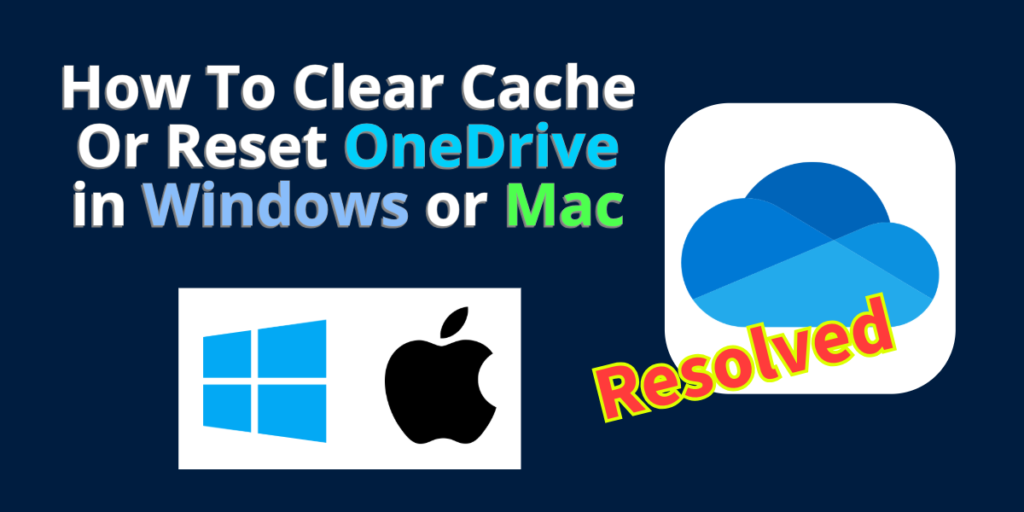How To Clear Cache Or Reset OneDrive App in Windows or Mac
OneDrive, Microsoft’s cloud storage service, is a vital tool for many users who need to store and access files across multiple devices. However, there are times when you might experience issues such as syncing problems, corrupted files, or app malfunctions. Clearing the cache or resetting the OneDrive app can often resolve these issues. In this guide, we’ll walk you through the steps to clear the cache or reset the OneDrive app on both Windows and Mac systems.
Before we dive in, let go over some important stuff to give a you a peace of mind:
Why You Need to Clear Cache or Reset OneDrive
Clearing the cache or resetting OneDrive can address several common issues, particularly in the following scenarios:
- Work Account Changes:
- When you have a work account with your company or business and you update/change your email address ID or domain name, OneDrive may struggle to sync properly. This can lead to conflicts and errors that impede access to your files.
- Resetting OneDrive helps re-establish a fresh connection with your updated credentials, ensuring smooth and accurate syncing.
- Personal or Business OneDrive Issues:
- If your personal or business OneDrive is experiencing issues such as continuous syncing, missing files, or corrupted files, clearing the cache can remove any temporary data causing these problems.
- Resetting the app can resolve deeper software glitches or bugs by reinstalling the app’s configurations and settings.
By clearing the cache or resetting OneDrive, you can eliminate these disruptions and restore the functionality and reliability of your cloud storage.
Will I Lose Any Data While Cleaning Cache or Resetting OneDrive?
One common concern is whether data will be lost during this process. The good news is that:
- Clearing the Cache: This action only removes temporary files that OneDrive creates for syncing purposes. It does not affect your actual data stored in OneDrive.
- Resetting OneDrive: While this action may remove local copies of your files from your device, it does not delete your files from the cloud. Once you log back into OneDrive after resetting, your files will resync to your device.
However, it is always good practice to ensure that all your important files are backed up before performing these actions.
How To Clear Cache Or Reset OneDrive App in Windows or Mac
Windows
Clearing the cache or resetting OneDrive on a Windows computer can resolve various issues. Here are the steps to follow:
- Press
Win + Rto open the Run dialog box. - Type the following command and press Enter:
%localappdata%\Microsoft\OneDrive\onedrive.exe /reset - If you see a “Windows cannot find…” message, copy and paste the text below instead, then press OK.
C:\Program Files\Microsoft OneDrive\onedrive.exe /reset - If you see a “Windows cannot find…” message, copy and paste the text below instead, then press OK.
C:\Program Files (x86)\Microsoft OneDrive\onedrive.exe /reset - Wait for a few moments while OneDrive resets. You may see the OneDrive icon disappear and reappear in the system tray.
- If OneDrive does not restart automatically, open it manually by typing
OneDrivein the Windows search bar and selecting the OneDrive app. - Start OneDrive and finish the setup process.
Mac
Resetting or clearing the cache for OneDrive on a Mac involves a few different steps. Here’s how to do it:
- Open Finder and go to the
Applicationsfolder. - Right-click on the OneDrive app and select
Show Package Contents. - Navigate to
Contents/Resources. - Double-click ResetOneDriveApp.command (or ResetOneDriveAppStandalone.command, if you’re using the standalone app).
- Start OneDrive and finish the setup process.
Conclusion
Clearing the cache or resetting the OneDrive app can often resolve common issues such as syncing errors and application crashes. By following the steps outlined for Windows and Mac, you can ensure that your OneDrive app runs smoothly. Regular maintenance like this can help keep your OneDrive experience seamless and efficient. If problems persist, consider checking for updates or reaching out to Microsoft Support for further assistance.








